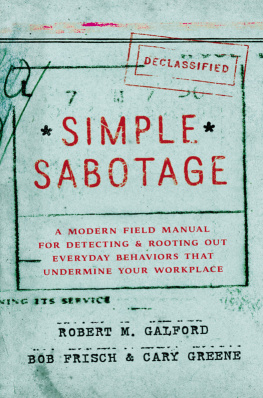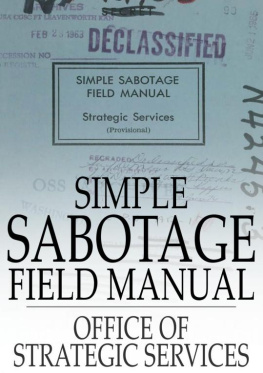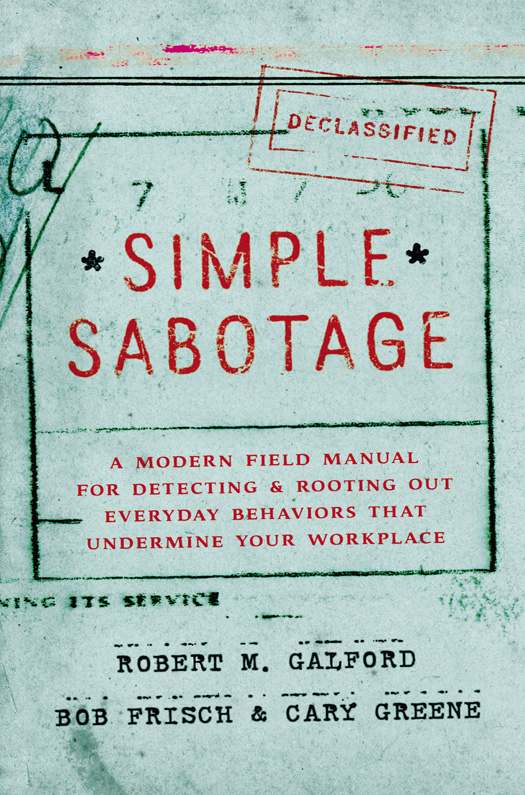To Susan, Katy, and Luke
Jacob, Adam, Noah, and Rachael
Jennifer, Ethan, and Eva
Contents
Guide
I n January 1944, at the height of World War II, the Office of Strategic Services (OSS)the predecessor of todays Central Intelligence Agencypublished an extraordinary classified document. OSS operatives, under the direction of General William J. Wild Bill Donovan, had been organizing and training members of the European resistance movement in tactics of sabotage. These techniques were presented in a slim volume, the Simple Sabotage Field Manual, which was printed in several languages and smuggled to Allied supporters behind enemy lines. The Manual detailed easy ways to disrupt and demoralize the enemys institutions without being detected. The authors intentions were clear: Slashing tires, draining fuel tanks, starting fires, starting arguments, acting stupidly, short-circuiting electric systems, abrading machine parts will waste materials, manpower and time. Occurring on a wide scale, simple sabotage will be a constant and tangible drag on the war efforts of the enemy.
The cumulative effect of these thousands of barely detectable individual acts would wear down the Axis powers and prevent them from achieving their goals. While planes and tanks and ships battled the enemy on the front, the OSS and resistance fighters would use the techniques from the Manual to attack from within.
Much of the volume was devoted to physical acts of sabotageof the put-sand-in-the-gas-tank or leave-oily-rags-in-a-pile variety. It advocated leaving saws slightly twisted when you are not using them as they would then eventually break when in use. It suggested clogging lubrication systems with any available substance. Twisted combings of human hair, pieces of string, dead insects, and many other common objects, the book advised, will be effective in stopping or hindering the flow of oil through feed lines and filters. It recommended sprinkling rock salt or ordinary salt profusely over the electrical connections of switch points and on the ground nearby. When it rains, the switch will be short-circuited.
Cooling systems, fuel lines, railroad switches, electric motors, gears, telephones, toilets, tiresthe Manual had great advice on how to cause trouble all around, and how to not attract attention while doing so.
But one section of the Manual was devoted entirely to the methodical disruption of the enemys organizationsin particular, their decision-making processes and the efficacy of their meetings and procedures.
The tactics described in this section were incredibly subtleand devastatingly destructive. They were like viruses, piggybacking on normally benign activities as they spread and accumulated. And, like viruses, they carried the ability to weaken or render impotent the organizational infrastructure of the enemy. They were also difficult to spot, challenging to mitigate or reverse, and almost impossible to prevent.
These are the eight tactics from the Simple Sabotage Field Manual:
1. Insist on doing everything through channels. Never permit short-cuts to be taken in order to expedite decisions.
2. Make speeches. Talk as frequently as possible and at great length. Illustrate your points by long anecdotes and accounts of personal experiences. Never hesitate to make a few appropriate patriotic comments.
3. When possible, refer all matters to committees, for further study and consideration. Attempt to make the committees as large as possiblenever less than five.
4. Bring up irrelevant issues as frequently as possible.
5. Haggle over precise wordings of communications, minutes, resolutions.
6. Refer back to matters decided upon at the last meeting and attempt to re-open the question of the advisability of that decision.
7. Advocate caution. Be reasonable and urge your fellow-conferees to be reasonable and avoid haste which might result in embarrassments or difficulties later on.
8. Be worried about the propriety of any decisionraise the question of whether such action as is contemplated lies within the jurisdiction of the group or whether it might conflict with the policy of some higher echelon.
These eight tactics sound relatively harmless, dont they? In fact, arent they aspects of the very behaviors that are necessary to the health of any group of people working together? For example, channels are important. Theyre vital communications tools that ensure that ideas are vetted thoroughly and that once a decision is made, the resources and skills needed to go forward with implementation are there. Caution is important too. If people threw caution to the winds and constantly took a ReadyFireAim approach, chaos would reign.

The eight tactics for interfering with organizations and production from the Simple Sabotage Field Manual, 1944.
Bear in mind: The OSS anticipated just that reaction. OSS leaders didnt want members of the Resistance caught and killed. Thats why the tactics they taught had strong plausible deniability. These are good behaviors, but taken to an extreme. Thats why they are insidious.
This was powerful stuff in 1944 and remains so today. Although the Manual has long been declassified, the acts of sabotage recommended in it are no less subtle and no less corrosive than they were more than seventy years ago. Whats more, they occur every day and all around the world in all sizes and types of working groups, from global corporations and nonprofits, to school and church committees, to small businesses. Some of them, no doubt, occur in yours.
We are not suggesting that enemies are lurking in your midst. Its unlikely that youve got an internal resistance movement doggedly working to keep you from achieving your goals. But the odds are great that some individuals have unwittingly taken a page or two from the Manual. Left unchecked, their behaviors will, at the least, undermine your group or organization, slowing down itsand yourbest efforts. In the worst-case scenario, they will grind the gears to a halt.
Weve shared this list of OSS tactics with hundreds of our friends, colleagues, and clients. Almost every time theyve responded with a chuckle, That list describes my [department, company, volunteer group, book club, board]pick one; weve heard them all.
Thats why we wrote this book. In our decades of experience working with individuals and groups in organizations large, small, public, private, and nonprofit, weve seen these corrosive tactics at work. Weve witnessed the damage they do, and weve worked with clients across industries and continents to devise ways to recognize, counteract, and prevent them.
The OSS presented eight tactics for sabotaging an organization. This book tackles one in each chapter. In the process of writing about the countermeasures to these tactics, however, weve also realized that as new organizational forms have taken shape and new technologies have emerged over the past few decades, so have new opportunities to throw a monkey wrench into the works. So we devote an additional chapter to one of the most effective (which is to say damaging) new tactics of sabotage that have become commonplace since the Manual was written.
You will probably find most of the sabotage techniques discussed in this book familiar. You might even laugh at some of them, thinking they are nothing more than some peoples quirky or annoying behaviors. You might believe that they are easily corrected. Well, you might think, I can just point these things out to my colleagues, or direct reports, or even my boss, and the behaviors will stop; problem solved.













